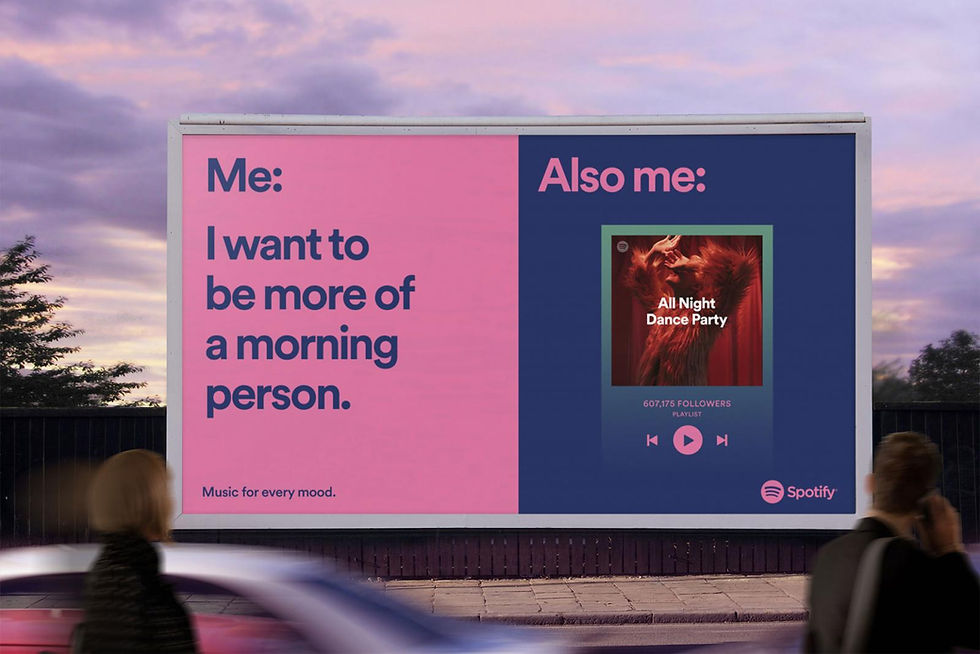Spotify Case Study
- Sierra Myers

- Jun 3, 2020
- 4 min read
Spotify is a music streaming service provider that began as a startup. This Swedish born company was founded by Daniel Ek and Martin Lorentzon. Spotify was started as a solution to the worldwide piracy problem. The founders felt that music would be downloaded for free whether it was legal or not and therefore felt it was important to find a way for people to access downloads in a way that would be more beneficial to the artists. Ek and Lorentzon feel they have found a way for people to pay for those downloads at a reasonable price without taking away the convenience factor. This method diminished the use of illegal download softwares such as LimeWire.
This company’s biggest rival is Apple Music. Apple Music is one of the most common streaming services and it has many partnerships that make it even more popular. For example, people with certain data plans with Verizon Wireless receive the benefit of free Apple Music. Two other competitors are Amazon Music Unlimited and Google Play. The upper hand that these two companies have is that they have also produced speakers that are specific to their streaming network. These sleek and minimal speakers include an intelligence assistant. Their use of “Okay Google” and amazon’s version, Alexa, puts them ahead of Spotify.
They have also struggled with gaining support from some artists. Recording artists such as Jay Z, Beyoncé and Taylor Swift have refused to allow their music to be available for streaming on Spotify. Jay Z has gone as far as building his own streaming network called Tidal, and this is where most of Jay Z and Beyoncé’s music is available.
Lately, Spotify has grown its audience by adding podcasts to its streaming content. The future of Spotify is unknown. According to an article written by Tim Ingham at Rolling Stone it is possible that another company would benefit from buying Spotify in the near future. Just few of the companies that are rumored to have interest are Netflix, Samsung and Facebook.
“Music for Every Mood” Advertising Campaign

In 2019 Spotify introduced a campaign that used the layout of a popular meme on billboards. As seen in the picture below Spotify used the tagline “Music for every mood” for this campaign. June Sauvaget spoke to Rolling Stone about this campaign and said, “This multifaceted campaign sets the stage as we seek to deepen our connection with the people who already know and love Spotify and cultivate relationships and moments of discovery in areas of the world where we are looking to expand.” consumer and product marketing
Objectives
Spotify’s goals for this campaign was to raise the number of millennial and gen z users and to gain new attention from other generations. Their hope was to use this campaign to use popular feelings and life events to show their audience that they have a playlist to match it.
Strategies and Tactics
There were a few tactics used to make this campaign successful. The first was that they implemented pop culture with memes to make themselves relatable. These billboards evoked a feeling of relatability. Another tactic was making people feel understood. There were a few about heartbreak and work life that made people feel like they were not alone with their feelings and that there are others who felt similar. Spotify used that and then recommended they play certain music to match it. The third tactic is the use of humor. Even for ones about heartbreak and frustrating work environments provoked humor for its viewers.
Audience
The audience for this campaign was mainly those who fit into the generation of Millennials and gen z. However, the nature of their campaign provoked interest from those of all ages.
Specifying Media Channels
For this campaign Spotify chose to use mostly physical ad space that existed in their audience’s everyday life. To my knowledge and in my findings, this was not a campaign that was also used in their digital marketing until they released the video portion.
Implementing and Monitoring the Campaign
While implementing this as campaign Spotify chose to run it in countries where they already had a pretty large following. Because of this the ads ran mostly in Australia, Canada, New Zealand, the Netherlands, Germany, Sweden, the U.K., and the U.S. They were most common in Australia and New Zealand. As the campaign grew Spotify also began releasing short 30 second videos that showed a real-life experience sound tracked by a Spotify playlist. These experiences were average such as taking the stairs instead of the elevator and trying to wake up in the morning.
Evaluation and future planning
In addition to the tagline “Music for every mood” they also introduced podcast specific advertisements. The tagline for these ads was “A Podcast for every mood”. Although I could not find specific information regarding the details of this campaign my research suggests that it ran from about April of 2019 to December of 2019.
Personally, I believe that this was an incredible campaign idea. It is so witty and creative and I love how relatable they made the different memes. I also loved how there was really something for everyone. By this I mean that there was a different meme for different personalities and demographics. They only thing I do think they could have done to improve the campaign would be to take it further and made it more popular on social media platforms. This would have helped it to reach even more viewers.
Resources



Comments